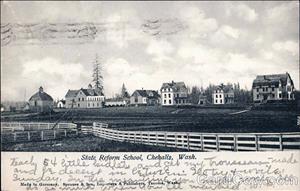On June 10, 1891, the Washington State Reform School opens in Chehalis. The school for youth ages 8 to 18 who commit crimes or are orphaned has more than 60 boys and girls in residence. The state legislature mandates that the students will be, "taught and trained in morality, temperance and frugality, and they shall also be instructed in the different trades and callings of the two sexes, as far as possible, in the scope of the institution" (1889-90 Wash. Laws, 488). Additionally, the school will teach the regular school curriculum through grade eight. Prior to the reform school's opening, no other option existed for punishing young offenders or assisting children abandoned by their parents. The Seattle Times, in its commentary on the opening of the school wrote, "There are many young boys in the penitentiary of Washington who should never have seen the inside of that institution ... . [He should be where] he is faced about toward the light -- not from it" ("The Reform School," 4).
The school's facilities included a farm, workshops, living quarters, and classrooms. Students learned farming, tailoring, shoemaking, carpentry, laundering, machine work, dairy operations, and hog raising. They also received non-sectarian (albeit Christian) religious instruction.
In 1907, the school's name changed to Washington State Training School, and in 1913 the girls got their own institution, called Maple Lane, near Grand Mound. Most of the crimes committed by the youth, according to a 1915 article about the school, were listed as "incorrigibility." This was because, "charging a specific crime and making it a matter of record against the boy is not in harmony with the spirit of work which should follow such a commitment. The fact is recognized by this simple charge, 'incorrigibility'" (Cochran, 65-66).
The school had no fences and the children sometimes simply walked away. The railroad line ran close to the school grounds, providing a convenient method of escape. Not until the 1970s, however, would fences enclose the grounds and police diligently track down escapees.
Of the 190 boys living at the school in 1915, 21 had been abandoned by their parents. The average age was 15. Today, the institution, run by the Juvenile Rehabilitation Administration, and called Green Hill School, holds 203 inmates, with an average age of 17, and with far more serious offenses on their records. Today younger children are not sent to Green Hill, nor are orphaned children.
Green Hill School is administered separately from the state correctional system, as part of the Department of Social and Health Services. The school's goal continues to be training and reforming youth. The school offers academic classes and vocational training and works to help the boys gain new skills for living in the community.

